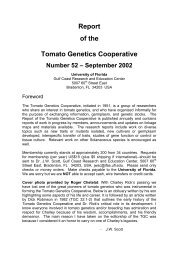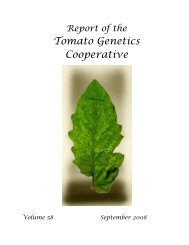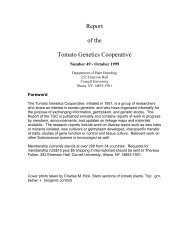Volume 60 - Tomato Genetics Cooperative - University of Florida
Volume 60 - Tomato Genetics Cooperative - University of Florida
Volume 60 - Tomato Genetics Cooperative - University of Florida
You also want an ePaper? Increase the reach of your titles
YUMPU automatically turns print PDFs into web optimized ePapers that Google loves.
Research Papers TGC REPORT VOLUME <strong>60</strong>, 2010<br />
Preliminary report on association <strong>of</strong> ‘Candidatus Liberibacter solanacearum’<br />
with field grown tomatoes in Guatemala<br />
Luis Mejía, Amilcar Sánchez, and Luis Méndez, Facultad de Agronomía, Universidad<br />
de San Carlos de Guatemala; D. P. Maxwell, Department <strong>of</strong> Plant Pathology,<br />
<strong>University</strong> <strong>of</strong> Wisconsin-Madison; R. L. Gilberston, Department <strong>of</strong> Plant Pathology,<br />
<strong>University</strong> <strong>of</strong> California-Davis; V.V. Rivera and G.A. Secor, Department <strong>of</strong> Plant<br />
Pathology, North Dakota State <strong>University</strong>, Fargo.<br />
Introduction<br />
A new disease <strong>of</strong> tomatoes has received considerable attention in the local<br />
newspapers in Guatemala. Locally, it is referred to “Paratrioza disease”, which refers<br />
to the insect associated with symptomatic plants. The symptoms on tomatoes are<br />
flower abortion, purple margins <strong>of</strong> youngest leaves, upward cupping <strong>of</strong> leaves,<br />
thickened stems and retarded internode growth, and stunting <strong>of</strong> the plants (Fig. 1). In<br />
Mexico, a disease <strong>of</strong> tomato with similar symptoms is called permanent damage<br />
disease or permanent yellowing disease (daňo permanente del tomate; Páramo<br />
Menchaca, 2007) and Munyaneza et al. (2009) reported that Candidatus Liberibacter<br />
solanacearum was associated with these plants. This unculturable bacterium is<br />
transmitted by the tomato/potato psyllid (Bactericerca (Paratrioza) cockerelli).<br />
Fig. 1. Typical symptoms associated with “Paratrioza disease” <strong>of</strong> tomato in<br />
Guatemala. Image taken December 2009 and shows flower abortion, purple leaf<br />
margins, cupping <strong>of</strong> leaves and thickened petioles and stems.<br />
In a tomato field (about 0.7 ha, at 1,500 m, Department <strong>of</strong> Sacatepéquez) where<br />
symptom incidence was over 90%, samples <strong>of</strong> young leaves with typical symptoms<br />
were collected in December 2009. DNA was extracted at San Carlos <strong>University</strong>,<br />
Guatemala City (Garcia et al., 2007). PCR was performed at North Dakota State<br />
54





